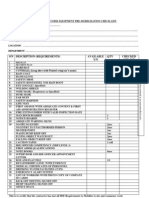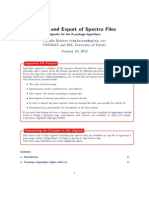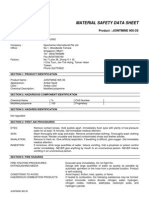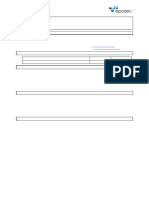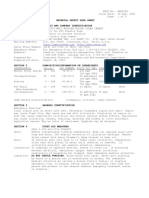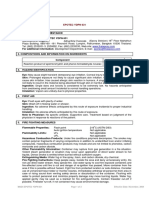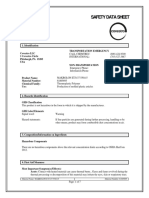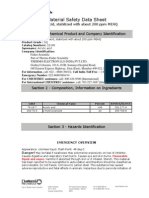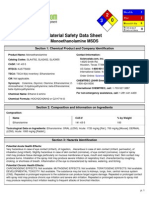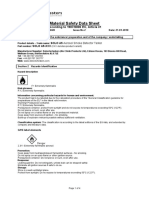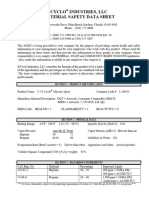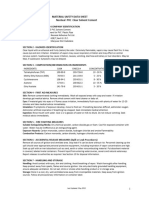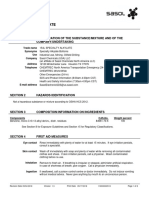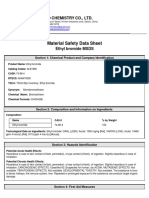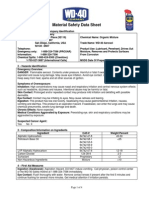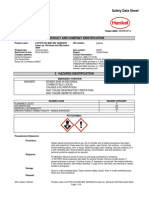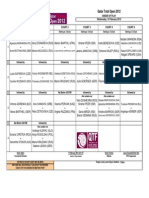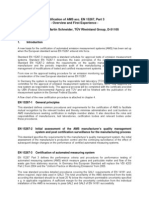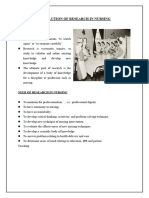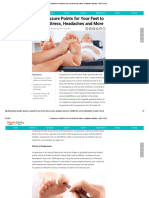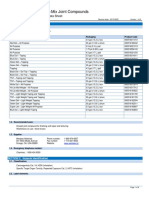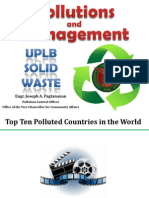Electron Msds
Electron Msds
Uploaded by
salekojic5332Copyright:
Available Formats
Electron Msds
Electron Msds
Uploaded by
salekojic5332Original Description:
Copyright
Available Formats
Share this document
Did you find this document useful?
Is this content inappropriate?
Copyright:
Available Formats
Electron Msds
Electron Msds
Uploaded by
salekojic5332Copyright:
Available Formats
Material Safety Data Sheet
ELECTRON
Environmentally Preferred Dielectric Solvent
Rev. 06/06/2007 2177A Flintstone Drive TUCKER, GA 30084 www.ecolink.com email: info@ecolink.com 800/886-8240 or 770/621-8240 (95 EST) FOR CHEMICAL EMERGENCY Call INFOTRAC 800/535-5053 (24 HOURS)
Section I: Product Identification
Product name: Synonym: Molecular Formula: ELECTRON Proprietary Blend Proprietary Blend
Section II: Chemical or Hazardous Components
Chemical Name CAS No. Approx. wt.% Exposure Chemical Name Citrus Terpene 68647-72-3 >10% (*) TLV 100 ppm
The Plain English Section
Material Safety Data Sheets can be confusing. Federal law requires us to print a great deal of technical information, which probably wont help the non-scientist. ECOLINK includes this PLAIN ENGLISH section, written to address the questions and concerns of the average person. If you have additional health, safety or product questions, dont hesitate to call us at 800/886-8240. Health Hazards: ELECTRON is a non-halogenated industrial chemical. We call it environmentally preferred because it is intended to replace products that are more hazardous, (1,1,1 trichloroethane, mineral spirits, MEK, etc.). This does not mean that ELECTRON is completely harmless. It is strong enough to remove tough industrial soils, so it can irritate your skin. We suggest you wear gloves, and avoid extended exposure to unprotected skin. Dont get it in your eyes, or breath large amounts of the vapor, (it will dry out your nasal passages). Used on a rag or from a spray bottle, the product wont produce fumes in any great quantity, (dont spray ELECTRON under high pressure without adequate ventilation). For more exposure and first aid information, refer to MSDS Sections II, VI. Flashpoint: ELECTRONs flashpoint is 147 F. This represents the temperature that the liquid must reach before it emits fumes that will ignite. This is pretty hot, so combustion in ordinary use isnt a big concern. If ELECTRON is used on rags, the rags can ignite if exposed to an open flame because the solvent is wicked onto the cloth. Be sure to dispose of rags in an airtight container specifically designed to prevent spontaneous combustion. Dont use ELECTRON or any other combustible solvent around welding or any other hot work area. Disposal: Straight from the drum, ELECTRON is not considered a hazardous waste product. Once it is contaminated with whatever you are cleaning, the resulting mixture may fall under a hazardous classification, depending on whether or not the material you are cleaning is hazardous. If you arent sure how to dispose of used ELECTRON, give us a call and we will help you make the right decisions.
Severely Hydrotreated Light Distillates CAS No. 64742-47-8 Approx. wt. % >75% Exposure (*) PEL 100 ppm (*) Manufacturers recommended exposure limits. ALL MATERIALS IN PRODUCT ARE TSCA LISTED RCRA REGULATED: No CERCLA (superfund): Not Applicable DOT regulated: No DOT haz. class: Not applicable DOT Shipping Name: Not applicable DOT number: Not Applicable (Questions concerning DOT information refer to DOT manual CFR 49, chapter 1, 10/96 edition)
Section III: Physical Data
Appearance & Odor: Boiling Point: Evaporation Rate: Percent Volatile: Solubility In Water: Specific Gravity: VOC Content Vapor Density (AIR=1): Vapor Pressure: Colorless liquid with mild citrus terpene odor 349 F. @ 760 mmHg <1.0 100% Negligible 0.8112 810 gm/l 122 gm/l less exempt compounds >1 0.30 mmHg @ 68F
Ecolink, Inc.
Material Safety Data Sheet ELECTRON
Page 1 of 3
Section IV: Fire and Explosion Hazard Data
Flash Point (Method): Bulk Liquid (TCC) 147 F Flammable Limits: LEL 0.7% UEL 7.0% Extinguishing Media: Regular foam, water fog, carbon dioxide, dry chemical, Class B. Special Fire Fighting Procedures: Keep fire exposed containers cool with water. Fire fighters should wear self-contained breathing apparatus with a full face piece operated in the positive pressure demand mode with appropriate gear and chemical resistant personal protective equipment. Unusual Fire & Explosion Hazards: Vapors are heavier than air and may travel along the ground or be moved by ventilation and ignited by heat, pilot lights, other flames and ignition sources at locations distant from material handling point. Never use welding or cutting torch on or near drum (even empty) because product can ignite explosively.
First Aid: Ingestion: Seek medical attention immediately. If individual is drowsy or unconscious, do not give anything by mouth; place individual on left side with head down. Contact medical facility or poison Control center for advice on whether to induce vomiting. Remove to fresh air. If breathing is difficult, give oxygen. Keep person warm and quiet. Seek medical attention. Irrigate immediately with water for at least 15 minutes. Get medical attention if irritation persists. Wash with soap and water. Thoroughly clean contaminated clothes and shoes before re-use. If symptoms persist, seek medical attention. Oral Toxicity (mice) LD50 5.66.6 g/kg Absorption (rabbits) LD50 >5000 mg/kg NTP Not Listed IARC Monographs None OSHA REGS Not Regulated
Inhalation:
Eyes:
Skin:
Toxicity Data: Acute Toxicity: Skin Toxicity: Carcinogen:
Section V: Reactivity Data
Stability: Stable Conditions to Avoid: Sources of ignition such as sparks, hot spots, welding, flames and cigarettes. Ignition/flash may result if concentration of product is in the flammable range. (See section IV for LEL and UEL values.) Incompatibility (Materials to Avoid): Strong oxidizing agents and/or strong acids. Hazardous Decomposition: May form carbon dioxide and carbon monoxide. Hazardous Polymerization: Will not occur.
Section VII: Precautions for Safe Handling
HMIS Information: Health 1 / Flammability 2 Reactivity 0 Personal Protection B
HMIS Definition: 0 Minimal, 1 Slight, 2 Moderate, 3 Serious, 4 Extreme / in the Health Category denotes material does not target any major organs. * in the Health Category denotes material may target certain organs. Eye Protection Safety glasses and splash protection required.
Section VI: Health Hazard Data
Primary Routes of Exposure: Oral, Inhalation, & Skin Ingestion: Swallowing large amounts may be harmful by causing gastrointestinal irritation. Inhalation: Breathing large amounts may be harmful by causing nose, throat, and respiratory tract irritation. Eyes: Irritant. Liquid contact will irritate eyes and may cause stinging, tearing, and redness. Skin or Contact: May cause mild irritation of redness and burning.
Protective Gloves: Nitrile gloves. Respiratory Protection: Not required under conditions of normal use. If vapor mist is present, use NIOSH certified organic vapor mask. Ventilation: Local exhaust/hood or fan may be used. Other Protective Clothing: None required under normal use. Work Practices: Store rags used with this material in an airtight, metal container to prevent spontaneous combustion. Treat this chemical with respect and follow all MSDS instructions.
Ecolink, Inc.
Material Safety Data Sheet ELECTRON
Page 2 of 3
Section VIII: Control Measures
Small Spill: Absorb liquid on vermiculite, floor absorbent, or other absorbent material and transfer to hood. Large Spill: Eliminate all ignition sources, (flares, flames including pilot lights, electrical sparks). Persons not wearing protective equipment should be excluded from area of spill until clean-up has been completed. Stop spill at source. Prevent from entering drains, sewers, streams, etc. If runoff occurs, notify authorities as required. Pump or vacuum transfer spilled product to clean containers for recovery. Transfer contaminated, absorbent soil and other materials to containers for disposal. Waste Disposal Method: ELECTRON is to be disposed of according to local, state, and federal regulations. Please call us if you need additional disposal information. Precautions To Be Taken In Handling & Storing: Since empty containers contain product residues, all hazard precautions given in the material safety data sheet must be observed. All metal pails or drums should be grounded and/or bonded when material is transferred. Any use of this product in elevated temperature processes should be thoroughly evaluated to establish and maintain safe operating conditions. Sudden release of hot organic chemical vapors or mists from process equipment operating at elevated temperatures may result in ignition. Other Precautions: Keep this and all chemicals out of the reach of children.
Section IX: Part Number & Packaging
Product Name Electron Electron Electron Electron Electron Part No. 0296-55 0296-5 0296-1 049-1 0164-1 Packaging 55 Gal Drum 5 Gal Pail 4x1 Gal BX 12 x 22 oz 12 Pt BX NSN Number 6850-01-375-5555 6850-01-375-5553 6850-01-375-5554 6850-01-371-8049 N/A
DISCLAIMER: Ecolink, Inc. believes the information contained herein is accurate. However, Ecolink makes no warranty, expressed or implied, regarding the accuracy of this data or the results to be obtained by the use thereof. Ecolink, Inc. assumes no responsibility for injury from the use of the product described herein.
END OF MSDS
Ecolink, Inc.
Material Safety Data Sheet ELECTRON
Page 3 of 3
You might also like
- The Health & Safety Guide for Film, TV & Theater, Second EditionFrom EverandThe Health & Safety Guide for Film, TV & Theater, Second EditionRating: 4 out of 5 stars4/5 (1)
- Pre Mob ChecklistDocument2 pagesPre Mob Checklistthewhiteeagle80% (10)
- MSDS Mita Emery Oil 6007509Document7 pagesMSDS Mita Emery Oil 6007509jesuscasasNo ratings yet
- Msds PDFDocument5 pagesMsds PDFVicky SLayzher SevenfoldismNo ratings yet
- Import and Export of Spectra FilesDocument21 pagesImport and Export of Spectra Filessalekojic5332No ratings yet
- Abocoat 8508 1 SDSDocument10 pagesAbocoat 8508 1 SDSVictor CarvajalNo ratings yet
- Aerochem Veiligheid Mono Ethylene GlycolDocument6 pagesAerochem Veiligheid Mono Ethylene Glycolsales putrariNo ratings yet
- Msds of EdcDocument13 pagesMsds of EdcMohamed AnwrNo ratings yet
- Carboline 890 Part ADocument6 pagesCarboline 890 Part AclintonNo ratings yet
- 905 3SDocument4 pages905 3SyasafyNo ratings yet
- YD128 - KUKDO EpoxyDocument3 pagesYD128 - KUKDO EpoxyBarry MilburnNo ratings yet
- Msds MFG 4141 - MoldReleaseConctrtDocument3 pagesMsds MFG 4141 - MoldReleaseConctrtJean ValjeanNo ratings yet
- Msds - MEK 1 1Document6 pagesMsds - MEK 1 1Ishaan RajNo ratings yet
- Material Safety Data Sheet: Section 1 Identification of The Substance/Preparation and of The Company/UndertakingDocument5 pagesMaterial Safety Data Sheet: Section 1 Identification of The Substance/Preparation and of The Company/UndertakingAnonymous gUySMcpSqNo ratings yet
- Eletric-Weld PVC Regular Bodied Clear CementDocument5 pagesEletric-Weld PVC Regular Bodied Clear CementMarcelo SimoesNo ratings yet
- Print PDFDocument6 pagesPrint PDFseptika5426No ratings yet
- Material Safety Data Sheet: Section 1 - Chemical Product / Company InformationDocument6 pagesMaterial Safety Data Sheet: Section 1 - Chemical Product / Company Informationceemore300No ratings yet
- Epotec Yd PN 631 SDSDocument3 pagesEpotec Yd PN 631 SDStrường phạm0% (1)
- Yd128 MsdsDocument3 pagesYd128 Msdsapi-263411629No ratings yet
- MsdsDocument6 pagesMsdsRoby SuheriNo ratings yet
- Material Safety Data Sheet: (Acute and Chronic)Document4 pagesMaterial Safety Data Sheet: (Acute and Chronic)Muhammad Andhika AlfaridziNo ratings yet
- Safety Data Sheet: Material Name: MAKROLON ET3137 550115 Material Number: 81805695Document7 pagesSafety Data Sheet: Material Name: MAKROLON ET3137 550115 Material Number: 81805695DiegoTierradentroNo ratings yet
- Etyl Mercaptan MSDSDocument24 pagesEtyl Mercaptan MSDSmostafa_1000100% (1)
- Material Safety Data Sheet: Section 1 - Chemical Product and Company IdentificationDocument16 pagesMaterial Safety Data Sheet: Section 1 - Chemical Product and Company IdentificationAnis FatehahNo ratings yet
- MEADocument6 pagesMEAGhifaris VashaNo ratings yet
- Solo Msds0086uk - Solo A5Document4 pagesSolo Msds0086uk - Solo A5Taufiq Omar HasanNo ratings yet
- C33 2002 MSDSDocument4 pagesC33 2002 MSDSMamdouhNo ratings yet
- PVC SolventDocument3 pagesPVC SolventGhay TNo ratings yet
- MSD Eg 20Document5 pagesMSD Eg 20Julio MendezNo ratings yet
- Black Plastic MEK Ink Part No 302-1003-001 - TINTADocument9 pagesBlack Plastic MEK Ink Part No 302-1003-001 - TINTAAlexander MamaniNo ratings yet
- Minimum Oil Circuit BreakerDocument4 pagesMinimum Oil Circuit BreakergshdavidNo ratings yet
- MSDS AAY0953.PDF - Topcoat YellowDocument7 pagesMSDS AAY0953.PDF - Topcoat YellowdevdossbNo ratings yet
- Sds Detail PageDocument6 pagesSds Detail PageLucas Gonçalves AlbinoNo ratings yet
- Aquapeel 510 MSDS PDFDocument4 pagesAquapeel 510 MSDS PDFCHANDRANo ratings yet
- Oatey PVC Regular Clear CementDocument5 pagesOatey PVC Regular Clear CementPaul Christian Rojas FloresNo ratings yet
- BenzinDocument6 pagesBenzinmicaziv4786No ratings yet
- Celcon Lw90-f2 BKDocument6 pagesCelcon Lw90-f2 BKalkanderNo ratings yet
- Phenolphthalein IndicatorDocument6 pagesPhenolphthalein IndicatorwindaratlinNo ratings yet
- FISPQ LPS CFC FreeDocument7 pagesFISPQ LPS CFC FreeFernando AugustoNo ratings yet
- 6c9c5993-92c1 - US - V-154L SPECIALTY ALKYLATE - EN-USDocument8 pages6c9c5993-92c1 - US - V-154L SPECIALTY ALKYLATE - EN-USAndre SantillanaNo ratings yet
- Material Safety Data Sheet: Ethylene GlycolDocument9 pagesMaterial Safety Data Sheet: Ethylene GlycolsahilchemNo ratings yet
- Ethylene Glycol Msds 2Document9 pagesEthylene Glycol Msds 2sahilchemNo ratings yet
- Loctite 406Document7 pagesLoctite 406ramstoriesNo ratings yet
- Butyl Acrylate MSDS: Section 1: Chemical Product and Company IdentificationDocument6 pagesButyl Acrylate MSDS: Section 1: Chemical Product and Company IdentificationsafaldNo ratings yet
- Msds OctaneDocument5 pagesMsds Octanenirmal_subudhiNo ratings yet
- Asia Wd40 Aerosol Msds 2012Document4 pagesAsia Wd40 Aerosol Msds 2012Sarliza JafarNo ratings yet
- Hydraulicoil Awiso32 MsdsDocument7 pagesHydraulicoil Awiso32 Msdsjino471No ratings yet
- Genflex Roofing Systems, LLC Material Safety Data SheetDocument4 pagesGenflex Roofing Systems, LLC Material Safety Data SheetgjroddyNo ratings yet
- Safety Data Sheet: Delo Gold Ultra SAE 15W-40Document6 pagesSafety Data Sheet: Delo Gold Ultra SAE 15W-40Nasta Ina RobayasaNo ratings yet
- Bromoethane MSDSDocument6 pagesBromoethane MSDSJenia KachanNo ratings yet
- Material Safety Data Sheet Tpe (Lainer)Document7 pagesMaterial Safety Data Sheet Tpe (Lainer)luiscamposdiazNo ratings yet
- Polyken 2019 PrimerDocument5 pagesPolyken 2019 Primernrd9771No ratings yet
- Actellic 50 EcDocument9 pagesActellic 50 Ecnadi1onlyNo ratings yet
- Anabond 202 MSDSDocument4 pagesAnabond 202 MSDSPoovannan Prakash0% (1)
- Product and Company Identification: Safety Data SheetDocument6 pagesProduct and Company Identification: Safety Data SheetRatnadewi SerbiniNo ratings yet
- Metil AcrilatoDocument6 pagesMetil Acrilatosoulwizard00No ratings yet
- After a Disaster - Information to Help You and Your Family RecoverFrom EverandAfter a Disaster - Information to Help You and Your Family RecoverNo ratings yet
- Dust Explosion and Fire Prevention Handbook: A Guide to Good Industry PracticesFrom EverandDust Explosion and Fire Prevention Handbook: A Guide to Good Industry PracticesNo ratings yet
- Workplace Vocabulary for Esl Students: With Exercises and TestsFrom EverandWorkplace Vocabulary for Esl Students: With Exercises and TestsNo ratings yet
- Hybrid Electric & Alternative Automotive Propulsion: Low Carbon TechnologiesFrom EverandHybrid Electric & Alternative Automotive Propulsion: Low Carbon TechnologiesNo ratings yet
- VS 101.51Document4 pagesVS 101.51salekojic5332No ratings yet
- Vera Zvonareva (Rus) : Order of Play Wednesday, 15 February 2012Document1 pageVera Zvonareva (Rus) : Order of Play Wednesday, 15 February 2012salekojic5332No ratings yet
- Test Report - CE - LED Tube 60598-2-1Document26 pagesTest Report - CE - LED Tube 60598-2-1salekojic5332No ratings yet
- HP Color Laserjet CP1515nDocument4 pagesHP Color Laserjet CP1515nsalekojic5332No ratings yet
- Ground Impedance Tests - FOP Vs SGMDocument6 pagesGround Impedance Tests - FOP Vs SGMsalekojic5332No ratings yet
- Yara U T2 N2O F: Erification EportDocument35 pagesYara U T2 N2O F: Erification Eportsalekojic5332No ratings yet
- 40 - 4 Swivel Base en 15373Document5 pages40 - 4 Swivel Base en 15373salekojic5332No ratings yet
- Aac Spec 538011 PDFDocument31 pagesAac Spec 538011 PDFsalekojic5332No ratings yet
- Certification of AMS Acc. en 15267, Part 3 - Overview and First ExperienceDocument11 pagesCertification of AMS Acc. en 15267, Part 3 - Overview and First Experiencesalekojic5332No ratings yet
- The Environment Agency's Monitoring Certification Scheme (Mcerts) - and Recent CEN DevelopmentsDocument40 pagesThe Environment Agency's Monitoring Certification Scheme (Mcerts) - and Recent CEN Developmentssalekojic5332No ratings yet
- Applications and Uncertainties Associated With Measurements Using FTIR SpectrometryDocument37 pagesApplications and Uncertainties Associated With Measurements Using FTIR Spectrometrysalekojic5332No ratings yet
- Historcal-Evolution-of-Research-in-Nursing 2Document18 pagesHistorcal-Evolution-of-Research-in-Nursing 2nathsujitkr1980No ratings yet
- QuestionList - 2 Editable Version 1627985032Document15 pagesQuestionList - 2 Editable Version 1627985032Francis OcwichNo ratings yet
- Lesson 2 EnergyDocument11 pagesLesson 2 EnergyMichael John SongcuanNo ratings yet
- Graduate Handbook BiostatisticsDocument84 pagesGraduate Handbook BiostatisticsGogo0% (1)
- Essay DailyAWPDocument47 pagesEssay DailyAWPSatya BatthulaNo ratings yet
- WUKSHE516-A New Employee Health Declaration V2-0Document1 pageWUKSHE516-A New Employee Health Declaration V2-0Robsy AbrahamNo ratings yet
- MOA For Research - ReviewedDocument8 pagesMOA For Research - ReviewedSummerRainNo ratings yet
- PerDev Q1W6 The Power of MindDocument36 pagesPerDev Q1W6 The Power of Mindjzwf8m82gjNo ratings yet
- I Grand Prix Brasil Tournament-2022 InvitationDocument8 pagesI Grand Prix Brasil Tournament-2022 InvitationCarito MoralesNo ratings yet
- 4 Research Backed Tips Sticking New Years ResolutionDocument2 pages4 Research Backed Tips Sticking New Years ResolutionWinner#1No ratings yet
- Indore PortraitDocument8 pagesIndore PortraitAkshita JainNo ratings yet
- Professional Safety - April 2020Document60 pagesProfessional Safety - April 2020Antonio RamirezNo ratings yet
- OGL 481 Pro-Seminar I: PCA-Symbolic Frame WorksheetDocument5 pagesOGL 481 Pro-Seminar I: PCA-Symbolic Frame Worksheetcourtney schollmeyerNo ratings yet
- 7 Acupressure Points For Your Feet To Remove Stress, Headaches and More - NDTV FoodDocument9 pages7 Acupressure Points For Your Feet To Remove Stress, Headaches and More - NDTV FoodAdarsh PatilNo ratings yet
- Patient Name: Lorna Dimagiba Age: 84 Years Old Gender: Female C.S: Widow BED#: 1 Date / Shift/ Time Focus Notes (Data, Action, Response)Document4 pagesPatient Name: Lorna Dimagiba Age: 84 Years Old Gender: Female C.S: Widow BED#: 1 Date / Shift/ Time Focus Notes (Data, Action, Response)Fau Fau DheoboNo ratings yet
- Sexiest WeightDocument3 pagesSexiest Weightzkumalo_valentine0% (2)
- Lex Application Form Foreign TrainedDocument2 pagesLex Application Form Foreign TrainedMohammed AadeelNo ratings yet
- Lec.3 Facial PainDocument57 pagesLec.3 Facial PainHaider Dhiya NooriNo ratings yet
- SDS Westpac Ready Mix CompoundsDocument8 pagesSDS Westpac Ready Mix CompoundsSherif ShahinNo ratings yet
- Effects Nof Students' Alcoholism On Their Academic Performance in Jose Rizal Memotial State University, Dipolog CampusDocument5 pagesEffects Nof Students' Alcoholism On Their Academic Performance in Jose Rizal Memotial State University, Dipolog CampusbengNo ratings yet
- Breakfast Is The Important Meals of The DayDocument6 pagesBreakfast Is The Important Meals of The DayGeemol AlexNo ratings yet
- Desmodur XP 7100N: Aliphatic PolyisocyanateDocument2 pagesDesmodur XP 7100N: Aliphatic PolyisocyanateA MahmoodNo ratings yet
- GWL InaDocument25 pagesGWL Inatugba1234No ratings yet
- Hera Factsheet Health-Threat MCMDocument2 pagesHera Factsheet Health-Threat MCM周一行No ratings yet
- Sex-Linked Traits: General Biology Ii Jose Amado Ds. TorredaDocument11 pagesSex-Linked Traits: General Biology Ii Jose Amado Ds. TorredaDyames TVNo ratings yet
- ConventionsDocument2 pagesConventionsapi-253072512No ratings yet
- Kista Ovarii & Ginjal (USG&CTscan)Document22 pagesKista Ovarii & Ginjal (USG&CTscan)Alemania IkakusumaNo ratings yet
- BM 3Document33 pagesBM 3Ryan Joseph ConcepcionNo ratings yet
- Pollutions ManagementDocument67 pagesPollutions Managementmarcelinorocky100% (2)

